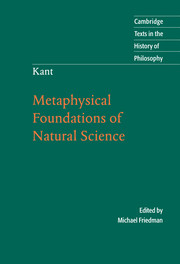Book contents
- Frontmatter
- Contents
- Acknowledgments
- Introduction
- Chronology
- Further reading
- Note on texts and translation
- Metaphysical Foundations of Natural Science
- Preface
- First Chapter Metaphysical Foundations of Phoronomy
- Second Chapter Metaphysical Foundations of Dynamics
- Third Chapter Metaphysical Foundations of Mechanics
- Fourth Chapter Metaphysical Foundations of Phenomenology
- Glossary
- Index
- Cambridge Texts in the History of Philosophy
Third Chapter - Metaphysical Foundations of Mechanics
Published online by Cambridge University Press: 05 June 2012
- Frontmatter
- Contents
- Acknowledgments
- Introduction
- Chronology
- Further reading
- Note on texts and translation
- Metaphysical Foundations of Natural Science
- Preface
- First Chapter Metaphysical Foundations of Phoronomy
- Second Chapter Metaphysical Foundations of Dynamics
- Third Chapter Metaphysical Foundations of Mechanics
- Fourth Chapter Metaphysical Foundations of Phenomenology
- Glossary
- Index
- Cambridge Texts in the History of Philosophy
Summary
Explication 1
Matter is the movable insofar as it, as such a thing, has moving force.
Remark
This is now the third definition of matter. The merely dynamical concept could consider matter also as at rest; for the moving force there dealt with had merely to do with the filling of a certain space, without the matter filling it needing to be seen as itself moved. Repulsion was therefore an originally moving force for imparting motion. In mechanics, by contrast, the force of a matter set in motion is considered as communicating this motion to another. It is clear, however, that the movable would have no moving force by means of its motion, if it did not possess originally moving forces, by which it is active in every place where it is found, prior to any inherent motion of its own. No matter would impress proportionate motion on another matter lying straight ahead and in the way of its motion, if both did not possess original laws of repulsion; nor could a matter, by its motion, compel another to follow straight behind it (to drag it along behind), if both did not possess attractive forces. Thus all mechanical laws presuppose dynamical laws, and a matter, as moved, can have no moving force except by means of its repulsion or attraction, on which, and with which, it acts immediately in its motion, and thereby communicates its own inherent motion to another.
Information
- Type
- Chapter
- Information
- Kant: Metaphysical Foundations of Natural Science , pp. 75 - 92Publisher: Cambridge University PressPrint publication year: 2004
